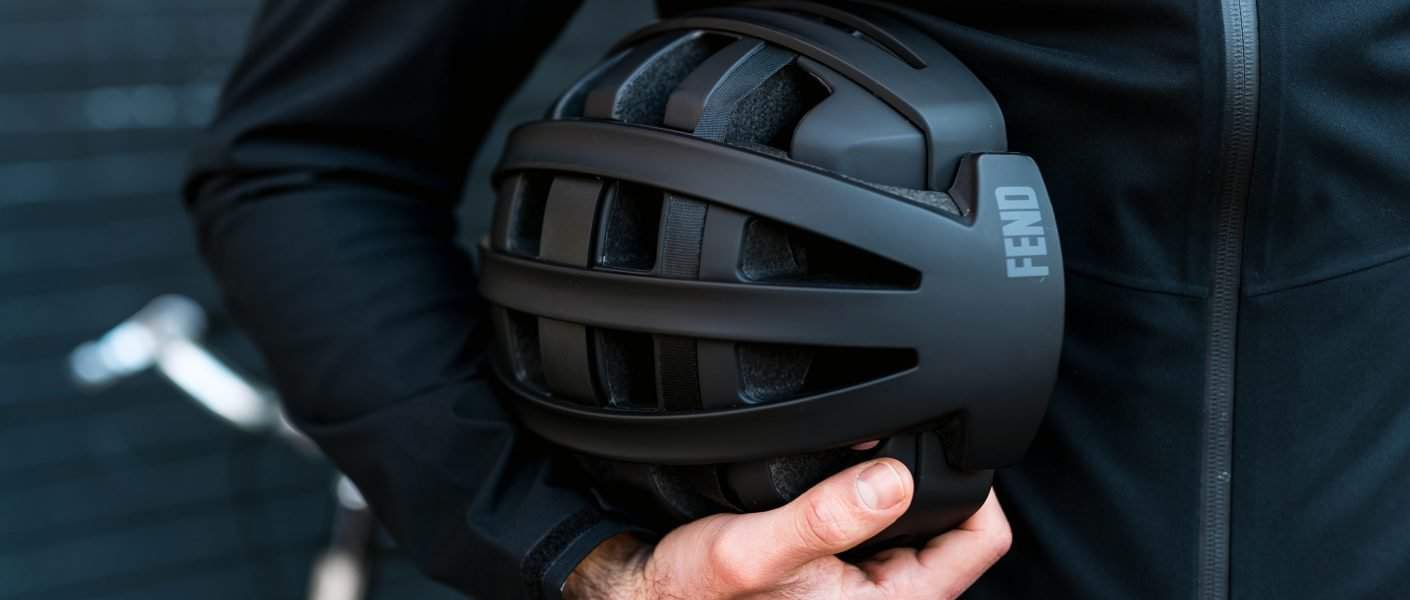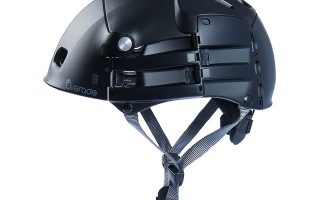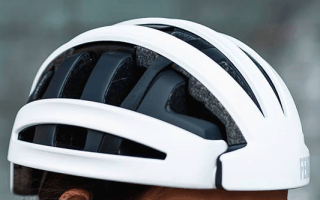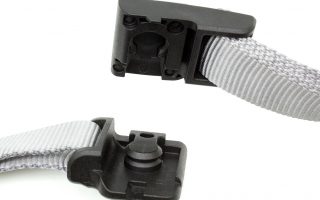One thing that really struck me when unboxing, researching and reviewing the FEND was how passionate the founders are about their product. It showed in everything from their backstory to the adorable thank you note tucked into their packaging. I can honestly say that I have no clue who created most of the products I consume, let alone know why the product was created, and frankly I don’t usually care. But the sincerity of the note and the origin story on the company’s website signaled to me that there was more to this helmet’s backstory than one might expect. Christian and Sujene, the creators of the FEND, graciously agreed to chat with us and give us some more information about their unique helmet and its impact on the future of cycling.
This exclusive interview has been condensed and lightly edited for clarity.
Tell us a little bit about your backstory.
Christian: Riding my bike everywhere was just how I got around and not wearing a helmet was part of my daily routine, mainly because it didn’t fit my lifestyle- I was just naive. One day, I was riding home from work on the Lower East Side in New York, and I was hit by a taxi. It was at nighttime, I did have a light on my bike, I was totally visible, but you know, stuff still happens. A cab turned in front of me, I went over my handlebars, over the hood, and landed in front of the cab. [I was] completely shocked, I didn’t even know what was going on. I was ok, I definitely had bumps and bruises but no head injuries, thank God. After limping home, and having to take a subway because I could no longer operate my bike, I sat there and at first I was like, man I’m such an idiot, why didn’t I wear a helmet, what’s wrong with me?!
…at first I was like, man I’m such an idiot, why didn’t I wear a helmet, what’s wrong with me?!
I started to search the internet, [thinking] maybe I should buy a helmet. Then I realized that I was just going to buy another helmet, and it’s just gonna sit there, unworn. That’s when I had this epiphany, that if I can’t find a helmet on the market that suits me, why don’t I try to design my own.
I had this epiphany, that if I can’t find a helmet on the market that suits me, why don’t I try to design my own.
My background is in design, and I’ve designed hundreds of products in the past, working for various companies. It all happened so quickly where I went from the initial concept to the very first prototype in about one week. I had my own 3D printer and built everything in CAD.
Sujene: My background is in fashion, with a focus on merchandising, buying, and sales. I’ve worked for various companies over the years, such as Burberry, Jimmy Choo, St. Laurent, Shiseido… I wasn’t even thinking about leaving my job at the time but it was too good of an idea to pass. I knew that this was something we could do that would actually change the way people commute. That was one of the biggest reasons why we both decided to quit our jobs, we were all in.

I knew that this was something we could do that would actually change the way people commute. That was one of the biggest reasons why we both decided to quit our jobs, we were all in.
Sujene with your background in fashion, I guess that fell to you then to make the helmet a bit more aesthetically pleasing than most of what’s on the market?
Sujene: Yeah, definitely. Aesthetics were a huge part of this process.
Aesthetics were a huge part of this process.
Christian: Throughout the entire development process, the aesthetic has changed and it has become, I think, much more refined than it initially was. And a lot of it is thanks to Sujene’s background in fashion.
Sujene: And the coolest thing is that we received a lot of press over the years. And not just from tech blogs, but it was across the board. We were featured in Vogue and different types of fashion magazines where you wouldn’t necessarily see a helmet. We’re really trying to change the way people think about helmets.
We’re really trying to change the way people think about helmets.
And just to make it more top-of-mind, but also to eliminate the stigma of this big bulky thing that you put on your head.
You had mentioned that you did like 30 different prototypes, and I was wondering if you could tell us a little bit more about the challenges you faced in bringing particularly a folding helmet to the market.
Christian: A helmet is just like any other product that you need many certifications for depending on where you’re selling it. We’re selling ours in the United States, Europe, Korea and Singapore. So the certifications are no joke. We spent a solid year and a half working towards this. Sujene and I actually moved across seas for about ten months and lived in our safety labs, pretty much. We ended up exceeding the safety standards which was mainly due to us constantly making refinements, and then also just coming up with a secret sauce in a sense that I don’t want to completely reveal, but this perfect engineering combination that we’re so incredibly happy and grateful for. And I know it just is all the hard work that we put into it.
Sujene: Our initial batch was meant to fulfill our Kickstarter backers and a small amount of preorders. We immediately ran out of inventory, and then went back into production. We sold out of inventory again, so now we’re on our third round.
Christian: So we technically have launched two versions of the helmet. We had version one, which we sold out of twice. And before we fulfilled the third batch, which is what we have right now, we made some optimizations – we made a couple adjustments to the strap so it doesn’t slide around, some adjustments to the overall headform, and we added the “find your fit” thicker padding in the box. Amazon reached out to us to sell on Amazon Launchpad which is a place that showcases innovative new products, so that’s now in the works. We’re also starting to fulfill through Amazon, so you can finally buy it through Prime, which will be a big thing.
We’re also based in New York and we see a lot of people riding without helmets. Do you see this changing now that folding helmets are becoming more of a thing?
Christian: They certainly are. When we started this, there were hardly any folding helmets on the market. The way I look at it is that there’s all this development and innovation happening around transportation and shared mobility with bike share and scooter shares everywhere. However, the safety side, not so much, and there are a number of reasons for that. Like it’s not nearly as sexy of a category. Also, anytime you put “safety” on something, it always gets a little bit of pushback. And so we set out to truly figure out the user experience behind that and why people don’t wear helmets. If you can start to design around those inconveniences, then you can start to obviously put more and more helmets on every rider’s head. And that’s really our mission, to protect all riders.
That’s really our mission, to protect all riders.
If you take a look at skiing and snowboarding and you go back say ten years ago, not a lot of people wore helmets. However, if you’re out on the slope today and you don’t have a helmet on, you’re really kind of frowned upon. And I think that there’s a transition happening right now with cycling where more and more people are starting to wear helmets. One, because they’re becoming more aware, and two, because they’re becoming more convenient. And those are two things that we’re really trying to push. Just because our helmet folds doesn’t mean that that is its main feature. The main feature is still aesthetics and safety first, and it just happens to fold.
Can you talk to us a little bit more about some of the unique challenges that New York City bikers face?
Sujene: Essentially, especially within New York, I think the infrastructure is one of the biggest challenges that bikers face, because there aren’t bike lanes on every street. The infrastructure needs to be a bit more developed, and more consistent. I was just reading a report from the Department of Transportation that was released this year on some bicycle statistics. They found that the majority of people who know how to ride a bike but don’t actually commute say they don’t because they feel like it’s not safe. Mainly due to the infrastructure, and also because they don’t wear helmets.
What’s your favorite place to ride in the city?
Christian: I love to ride everywhere in the city, even outside of the city. We like to go on these long century rides, and also rides around the city like the TD Five Borough Bike ride. My favorite is not riding for exercise or riding for anything more than just to be on a bike and to be able to commute and get to where I need to be as quick as possible. It’s what wakes me up in the morning, it’s what takes my stress away at night. I feel so at home on a bike, that I don’t really care where I’m riding as long as it’s somewhere in New York City.
Sujene: Yeah, I agree. I think there’s nothing like that feeling of efficiency but then also that you’re in control of your commute and your schedule which is really freeing. I also love to ride all over the city. I especially love riding on the bridges, I love the view of when you’re going across the George Washington Bridge or the Manhattan Bridge. Just that feeling of being across the water and seeing both sides of the city. To me, that’s pretty spectacular, and it reminds me of how awesome New York City is.
[Check out our review of the FEND helmet]




I was looking through some of your blog posts on this site and I think this site is real instructive! Continue posting .